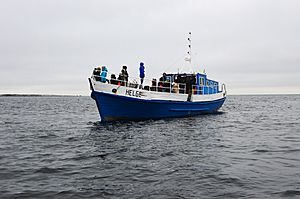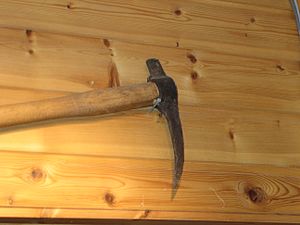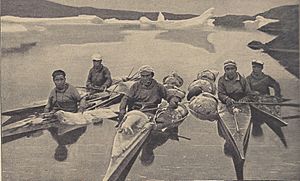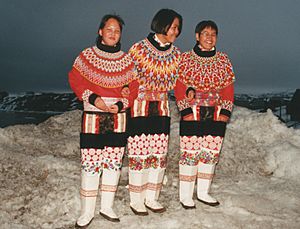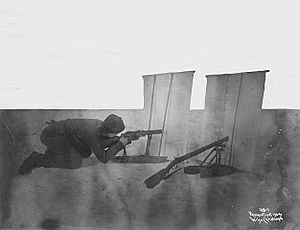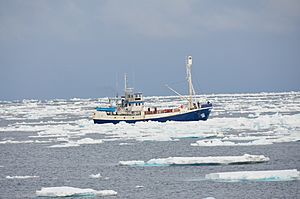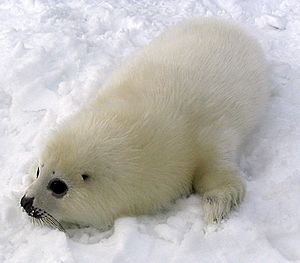Seal hunting facts for kids
Seal hunting, also known as sealing, is when people hunt seals. This practice happens in ten countries around the world. These include the United States (in Alaska), Canada, Namibia, Greenland (part of Denmark), Iceland, Norway, Russia, Finland, and Sweden. Most seal hunting today takes place in Canada and Greenland.
In Canada, the Department of Fisheries and Oceans (DFO) manages the seal hunt. They decide how many seals can be caught each year (called quotas). They also watch the hunt, study seal populations, and help sealers learn new rules. The DFO set quotas for hundreds of thousands of seals in recent years. However, the actual number of seals caught has often been less than the quota. For example, in 2010, the quota was 330,000 seals, but only 67,000 were caught.
In the late 1960s, the number of Harp seals in the northwest Atlantic dropped to about 2 million. This was because Canada was catching over 291,000 seals each year. People who care about animals asked for fewer seals to be hunted to prevent them from disappearing. In 1971, the Canadian government started a quota system. This system limited how many seals could be caught. A survey in 2007 estimated the harp seal population at 5.5 million.
In Greenland, hunters use firearms like rifles or shotguns. Young seals are fully protected there. This has caused some problems because Greenland was also affected by boycotts against seal products. These boycotts often targeted seals killed by clubbing, which is not used in Greenland. In Canada, it is against the law to hunt newborn harp seals (called "whitecoats") and young hooded seals (called "bluebacks"). Once harp seal pups start to lose their white fur, usually around 12-14 days old, they are called "ragged-jacket" seals. These can be hunted for money. After they lose all their white fur, they are called "beaters" because they beat the water with their flippers. The seal hunt is still a very debated topic. It gets a lot of attention from the news and causes many protests every year. Pictures from past hunts have become symbols for groups that work for conservation, animal welfare, and animal rights. In 2009, Russia stopped the hunting of harp seals less than one year old.
Contents
History of Seal Hunting
Seals are a diverse group of animals. Scientists group them with walruses into a larger group called Pinnipeds. The two main families of seals are eared seals (like sea lions and fur seals) and earless seals. Earless seals are also called hair seals. They are better swimmers than eared seals but move slower on land. People have used seals for their fur, meat, and fat. The fat was used for lamp fuel, lubricants, cooking oil, and to make soap.
Traditional Hunting Methods
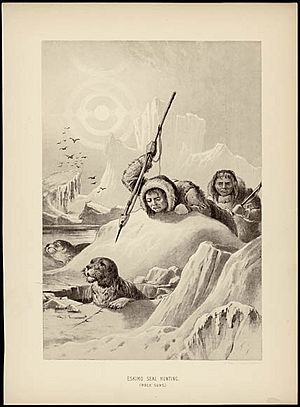
Evidence shows that Native Americans and First Nations people in Canada have hunted seals for at least 4,000 years. Traditionally, when an Inuit boy caught his first seal or caribou, a big celebration was held. Seal meat was a very important source of fat, protein, and vitamins. The pelts (skins) were valued for their warmth. The Inuit diet is rich in fish, whale, and seal.
For the Canadian Inuit, seals are not just a way to earn money from selling fur. They are a central part of their culture. The Inuit language, Inuktitut, has many words for things made from seal bone, sinew, fat, and fur. These include tools, games, thread, fuel, clothing, and tents. There are also words for seasons, places, legends, and family relationships that are based on the seal. One area of Canada's north is home to the Netsilik, or "people of the seal."
Inuit seal hunting makes up most of the seal hunt in Canada's north. However, it is only a small part (about three percent) of the hunt in southern Canada. The European Commission's call in 2006 for a ban on seal products did not include Inuit hunting. Ringed seals were once the main food source for Inuit. They were used for clothing, boots, fuel, and even igloo windows. Today, ringed seals are still an important food and clothing source for people in Nunavut.
People in northwest Europe and the Baltic Sea also hunted various seal species at least 8,000 years ago.
Early Commercial Hunting
The first time Europeans hunted seals for business was in 1515. A ship full of fur seal skins from Uruguay was sent to Spain to be sold.
Newfoundland Sealing
Newfoundland and Labrador and the Gulf of St. Lawrence were the first places where large-scale seal hunting happened. Fishermen started hunting seals there as early as the 1500s. Big commercial seal hunting became an annual event starting in 1723. At first, seals were caught in nets near the shore. This hunt was mainly for seal meat to feed the local communities.
From the early 1700s, English hunters began to go further out to sea. In 1723, hunters first used firearms from boats to catch more seals. This quickly grew into a big business. The seals were sent back to England, where their meat, fur, and oil were sold. Seal oil was used for lighting, cooking, making soap, and treating leather.
Sealing in the South Atlantic
Sealing became a major business in the South Seas from the late 1700s. The first commercial trip to the South Atlantic Ocean for whaling and sealing was in 1776.
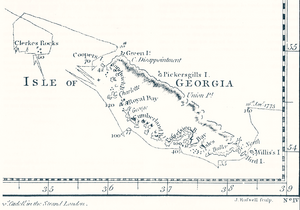
By 1784, Britain had fifteen ships hunting in the southern waters. By 1790, London alone had sixty ships in this trade. The sealing industry then moved further south to South Georgia island. This island was first mapped by Captain James Cook in 1775. In the late 1700s and throughout the 1800s, English and American sealers lived there for long periods. In 1778, English sealers brought back 40,000 seal skins and 2,800 tons of elephant seal oil from South Georgia. By 1791, 102 ships with 3,000 sealers were hunting seals south of the equator.
Seal hunters were not careful, and they hunted so many fur seals that the population almost disappeared. Because of this, sealing on South Georgia had three main busy periods. Between these times, the hunting decreased and slowly shifted to elephant seals, which were hunted for their oil.
Sealing in the Pacific
Commercial sealing in the Australasian region began around 1791 in New Zealand. Later, sealers focused on Bass Strait in Australia. By 1802, Bass Strait was over-hunted. So, commercial attention moved back to southern New Zealand waters. Sealers then explored and hunted around Stewart Island/Rakiura and Foveaux Strait. After that, they moved further south to the sub-Antarctic Auckland Islands and Campbell Island. This period of intense hunting is called the first sealing boom.
By about 1815, sealing in the Pacific became less important. It had a short comeback in 1823 but did not last. Even though it was very profitable at times, the lack of rules meant that sealing destroyed itself. By 1830, most seal populations in the Pacific were very low. In the North Pacific, large numbers of fur seals were hunted in the late 1800s, but these harvests also decreased as the seal populations dropped.
Industrial Era Sealing
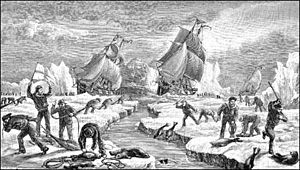
The Newfoundland hunt started with small schooners. From the 1830s to the mid-1840s, an average of 451,000 to 546,000 seals were killed each year. This caused the harp seal population to decline, which hurt the sealing business.
Sealing in Newfoundland reached its peak in the 1860s. This was when more powerful steamships were introduced. These ships could travel further and carry more seals. Annual catches went over 400,000 from the 1870s. Smaller sealing ships were pushed out of the market.
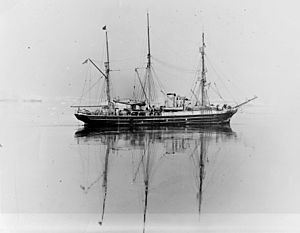
The first modern sealing ship was the SS Bear, built in Scotland in 1874. It was made for sealing out of St. John's, Newfoundland. The Bear was very strong, with thick wooden planks. It had sails but its main power was a steam engine designed to break through ice. This ship changed the sealing industry. It replaced hundreds of smaller sailing ships with large, expensive steamships owned by big companies. By the late 1800s, sealing was the second most important industry in Newfoundland, after cod fishing.
The seal hunt provided important winter jobs for fishermen. But it was dangerous work, and many lives were lost in sealing disasters. After World War II, large Norwegian ships dominated the Newfoundland hunt. Later, smaller motor fishing boats from local communities took over. In 2007, the commercial seal hunt brought about $6 million to Newfoundland's economy. This was much less than its importance in the past.
Protecting Seals and the Environment
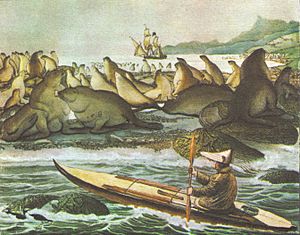
The end of the 1800s saw a disagreement between the United States and Great Britain over managing fur seal hunting in the Bering Sea. The U.S. bought Alaska and the nearby islands, including the Pribilof Islands, where many seals breed. The U.S. government made rules to control seal killing there. However, British and Canadian ships started hunting seals in the open ocean, outside the protected areas. The U.S. claimed it had the right to control sealing in the Bering Sea. It also said that protecting fur seals was a global responsibility. Britain disagreed but was willing to talk about international rules.
The issue went to a special court, which decided in favor of Britain in 1893. The court then set rules for both countries to protect the seal herds. These rules limited open-ocean sealing by time, place, and method. For example, seals could not be bothered within 60 miles of the Pribilof Islands. Only licensed sailing vessels could hunt, and using firearms or explosives was forbidden.
This was one of the first times rules were made for the sealing industry to protect the environment. However, these rules did not fully work because mother seals still fed outside the protected area. Scientists from Britain and the U.S. agreed that open-ocean sealing needed to be reduced.
Finally, the North Pacific Fur Seal Convention of 1911 greatly reduced the sealing industry. This treaty, signed by the United States, Great Britain, Japan, and Russia, aimed to manage the hunting of fur-bearing mammals. It banned open-water seal hunting. It was the first international treaty to deal with wildlife preservation.
Today, commercial sealing is done by only five countries: Canada, Greenland, Namibia, Norway, and Russia. The United States, which used to be very involved in sealing, now completely bans commercial hunting of marine mammals. However, indigenous peoples are allowed to hunt a small number of seals each year.
How Seals Are Hunted
In the Canadian commercial seal hunt, most hunters use a firearm to kill the seals. On the ice floes east of Newfoundland, where most non-native hunting happens, 90% of sealers use guns.
An older, more traditional way to kill seals is with a hakapik. This is a heavy wooden club with a hammer head and a metal hook. The hakapik is used because it is efficient. The animal can be killed quickly without damaging its fur. The hammer head crushes the seals' thin skulls, and the hook is used to move the bodies. Canadian sealing rules describe the size of clubs and hakapiks, and the type of rifles and bullet speed that can be used.
Modern Sealing and Products
What Seals Are Used For
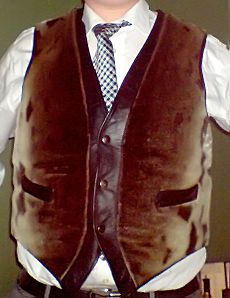

Aboriginal people have used seal skins for thousands of years to make waterproof jackets and boots. Seal fur is used for fur coats. The skins make up more than half the value of a seal. In 2006, a pelt could sell for over C$100. Some fashion designers use seal pelts, while others choose not to use any kind of fur.
Seal meat is a food source for people in small communities along the coast. Some meat is sold to Asian companies for pet food. Seal blubber (fat) is used to make seal oil, which is sold as a health supplement, like fish oil.
Countries That Hunt Seals Today
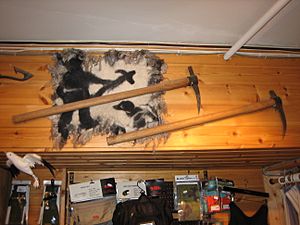
- Canada
- Greenland
- Namibia
- Norway
- Russia
The Seal Hunting Debate
Is Seal Hunting Sustainable?
In 2013, the Canadian Department of Fisheries and Oceans estimated the harp seal population at 7.3 million animals. This is more than three times what it was in the 1970s.
Before Europeans arrived, many more harp seals migrated to Newfoundland and Labrador. Hunting by settlers caused the population to drop. In the 1950s and 1960s, about 291,000 seal pups were killed each year. This led to the population falling to less than 2 million seals. People worried about the seals and demanded limits on hunting. So, in 1971, Canada started a quota system.
In 1983, the European Union banned importing pelts from whitecoat harp seal pups (very young seals). This caused the market for pelts to shrink. As a result, the number of seals killed dropped. During this time, the harp seal population grew. After the ban, the Canadian government and sealers found new markets for older seal pelts. In 1996, the number of seals killed went up again to over 200,000 each year.
Norway's seal hunt is now controlled by quotas based on scientific advice. However, sealing in Norway has decreased, and they often do not reach their quotas. Besides hunting, harp seal populations are also affected by climate change. They rely on strong sea ice for giving birth. A lack of sea ice in recent years has caused tens of thousands of newborn harp seal pups to drown.
Why Some People Object to Fur
Groups that advocate for animal welfare, like PETA, are against using real fur. They believe there are many good fake fur options available.
Economic Impact of Sealing
Canadian authorities say the seal harvest in 2004 was worth C$16.5 million. This money helps seal manufacturing companies and thousands of fishermen and First Nations people. Some sealers say the hunt provides a third of their yearly income. However, critics say this is a very small part of Newfoundland's C$600-million fishing industry. Opponents also argue that the money from sealing is small compared to the cost of managing and supporting the hunt. Some critics suggest that promoting the area for ecotourism (tourism focused on nature) would bring in more money than the annual hunt.
Is Sealing a Way to Control Seal Numbers?
In March 2005, Greenpeace asked the DFO to clarify if seals were preventing cod fish stocks from recovering. This suggested that the seal hunt might be partly a way to reduce seal numbers to help cod. Cod fishing has always been very important to the economy of Newfoundland and Labrador. Fisheries and Oceans Canada replied that there is no link between the seal hunt and the cod fishery. They stated that the seal hunt is based on good conservation principles.
Public Opinion on Sealing
Around the world, many people are against the seal hunt. This is similar to how they feel about other practices like bull fighting or whaling. In Canada, opinions depend on how close people live to communities that have a history of seal hunting. People in cities outside of Newfoundland and Labrador are more likely to be against it.
Protests Against Sealing
Many animal protection groups encourage people to protest the hunt. Some groups believe the hunt will only end if people stop buying Canadian seafood. In 2005, the Humane Society of the United States (HSUS) called for such a boycott in the U.S.
Protesters often use images of whitecoat seals, even though Canada bans commercial hunting of these suckling pups. The HSUS explains that pictures of legally hunted "ragged jackets" look very similar to whitecoats. They also state that most of the harp seals killed in recent years are under three months old.
In March 2006, seven anti-sealing activists were arrested for breaking rules about how close they could be to sealers. Five of them were later found not guilty. In the same month, Newfoundland and Labrador Premier Danny Williams asked people to boycott Costco. This was after Costco decided to stop selling seal oil capsules. Costco said their decision was not political, and they started selling the capsules again soon after.
In 2009, the European Union passed a law banning the import, export, and sale of most seal products. The Canadian government said it would take the European Union to the World Trade Organization if the ban did not make an exception for Canada. Canadian Inuit from Nunavut have spoken against the ban.
Impact on Inuit Communities
It is important to know that the southern Canadian seal hunt mainly targets harp seals, while Canadian Inuit usually hunt ringed seals. Greenlandic Inuit hunt both. Protests against the southern seal hunt have often affected Canadian and Greenlandic Inuit. When there is a ban on any type of seal product, even if Inuit hunting is exempt, the prices for Inuit-hunted seal products can drop. For example, in 1963, high-quality ringed seal pelts could sell for over $20. But in 1967, when the first big protests happened, the same pelts sold for only $2.50. This hurt Inuit communities.
Celebrities and the Debate
Many celebrities have spoken out against the commercial seal hunt. These include Sir Paul McCartney, Heather Mills, Pamela Anderson, and Brigitte Bardot. In March 2006, Brigitte Bardot traveled to Ottawa to protest the hunt. Paul and Heather Mills McCartney also visited the sealing grounds and spoke against the hunt on TV.
However, in 1978, marine ecologist Jacques Cousteau criticized the seal hunt protests. He said, "The harp seal question is entirely emotional. We have to be logical. We have to aim our activity first to the endangered species." He suggested that people who care about harp seals should also care about how pigs are treated.
Seal Hunting in Media
- Alethea Arnaquq-Baril's film Angry Inuk shows how seal hunting, Inuit poverty, and international trade bans are connected.
- Rudyard Kipling's story The White Seal, from The Jungle Book, tells about seal hunting from the seals' point of view.
- Jack London's novel The Sea Wolf takes place on a ship hunting seals in Japan around 1893.
- The topi enemy in the NES game Ice Climber was a seal in the Japanese version. But it was changed to a yeti in North American and European versions because of concerns about seal hunting.
See also
 In Spanish: Caza de focas para niños
In Spanish: Caza de focas para niños



